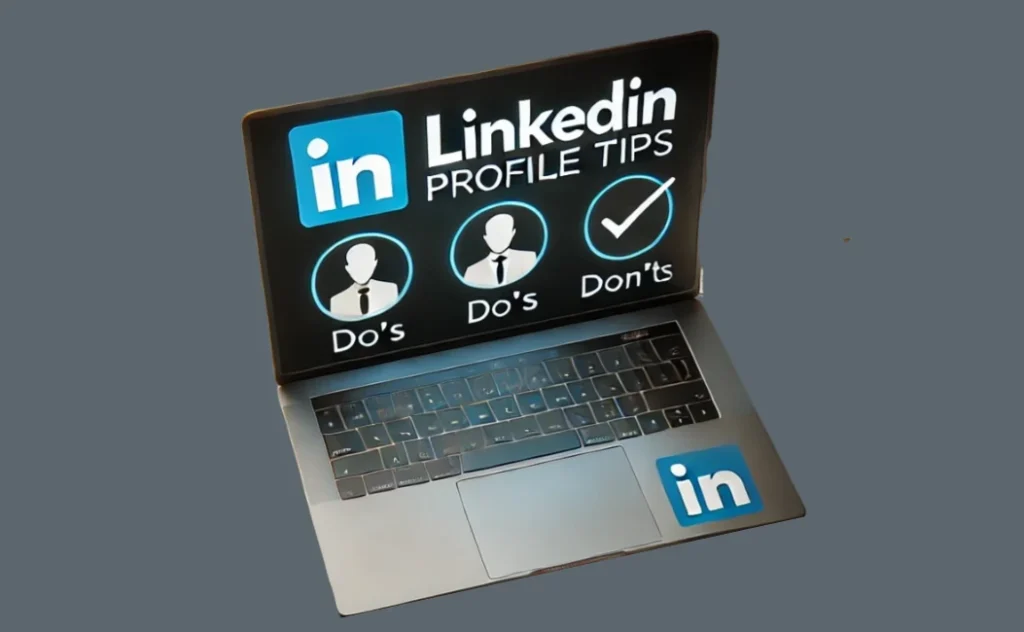Having a strong LinkedIn profile is essential for professionals aiming to enhance their online presence and attract potential employers or collaborators. Indeed, a well-structured profile not only showcases your expertise but also facilitates meaningful connections within your industry. Therefore, consider these key do’s and don’ts to ensure that your LinkedIn profile stands out.

First Impressions Matter
1. Profile Photo and Background
- Do: Use a high-quality, professional headshot where your face occupies about 60% of the frame. Moreover, ensure the background is uncluttered, and dress appropriately for your industry.
- Don’t: Avoid casual selfies, group photos, or images with distracting backgrounds. An unprofessional photo can significantly detract from your credibility.
2. Custom URL
- Do: Customize your LinkedIn profile URL to include your name, making it cleaner and more memorable (e.g., linkedin.com/in/YourName). Additionally, a personalized URL makes it easier for others to share and recall.
- Don’t: Leave the default URL with random characters, as it not only appears unprofessional but is also harder to distribute.
Professional Story
3. Headline
- Do: Craft a compelling headline that goes beyond your job title to showcase your expertise and value proposition. Furthermore, incorporating relevant keywords enhances your searchability.
- Example: Full-Stack JavaScript Developer | AI & Machine Learning Enthusiast | Building Scalable Web Solutions for Fintech Startups
- Don’t: Use a vague or default headline that fails to differentiate you from others in your field.
- Example: Software Developer at XYZ Company
4. About Section
- Do: Write a concise and engaging summary highlighting your skills, experiences, and what you offer. In addition, using a first-person narrative makes it personal and helps establish rapport with readers.
Example: Hey there! I’m a Full-Stack JavaScript Developer with a passion for transforming complex technical challenges into elegant, scalable web solutions. My journey began with a fascination for creating seamless digital experiences that solve real-world problems.
Specializing in React, Node.js, and modern JavaScript frameworks, I’ve helped fintech and SaaS startups build robust, high-performance applications. Whether it’s implementing cutting-edge frontend architectures or designing efficient backend systems, I thrive on pushing technological boundaries.
My toolkit includes:
- Frontend: React, Next.js, TypeScript
- Backend: Node.js, Express, GraphQL
- Database: MongoDB, PostgreSQL
- DevOps: Docker, Kubernetes, AWS
I’m not just about writing code—I’m about creating digital experiences that make a genuine impact. Let’s connect and explore how we can innovate together!
- Don’t: Copy and paste your résumé or employ third-person language, as such approaches can seem impersonal and fail to engage potential connections.
Showcase Your Expertise and Credibility
5. Experience and Skills
- Do: Detail your work experience with specific achievements and responsibilities. Also, list relevant skills and seek endorsements from colleagues to validate them.
- Don’t: Overload your profile with every job you have ever held or list irrelevant skills, as doing so may dilute your professional brand.
6. Recommendations
- Do: Request recommendations from peers and supervisors who can attest to your abilities and work ethic. In particular, these endorsements add substantial credibility to your profile.
- Don’t: Neglect this section entirely; lacking recommendations can make your profile seem less robust and potentially unreliable.
Engaging with Your Network and Industry
7. Content and Engagement
- Do: Share industry-relevant content, engage with your network’s posts, and participate in groups to increase visibility. Furthermore, thoughtful engagement demonstrates your commitment to your field.
- Don’t: Post excessively or share content unrelated to your professional interests, which can annoy your network and undermine your credibility.
8. Contact Information
- Do: Include up-to-date contact details to facilitate communication with potential employers or collaborators. Therefore, ensure that your email address, website links, or other channels remain active.
- Don’t: Omit contact information, making it difficult for interested parties to reach you, and possibly missing out on valuable opportunities.
Maintaining a Positive Professional Presence
9. Activity Notifications
- Do: Turn off activity broadcast notifications when making multiple profile updates to avoid spamming your network. Indeed, managing your notifications helps maintain a polished public image.
- Don’t: Overlook this setting, as leaving it on may lead to unnecessary updates that your network perceives as unprofessional.
10. Professionalism
- Do: Maintain a professional tone throughout your profile, ensuring all information is accurate and up-to-date. Additionally, review and refine your content from time to time to reflect your current professional standing.
- Don’t: Use informal language, include unverified claims, or leave outdated information that can mislead viewers and compromise your reputation.
Conclusion
By following these do’s and don’ts, you can create a LinkedIn profile that effectively showcases your professional identity and attracts valuable opportunities. Ultimately, implementing these best practices will help you stand out, connect with the right people, and advance your career in a meaningful way.